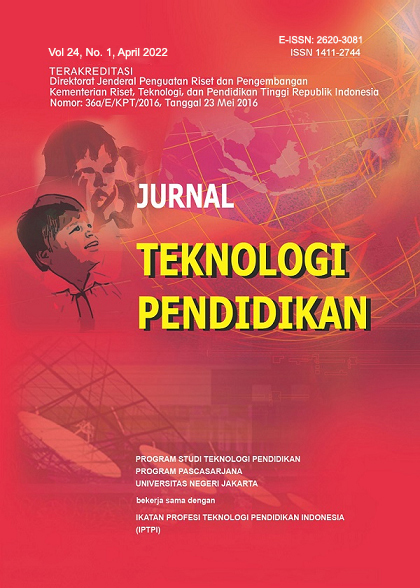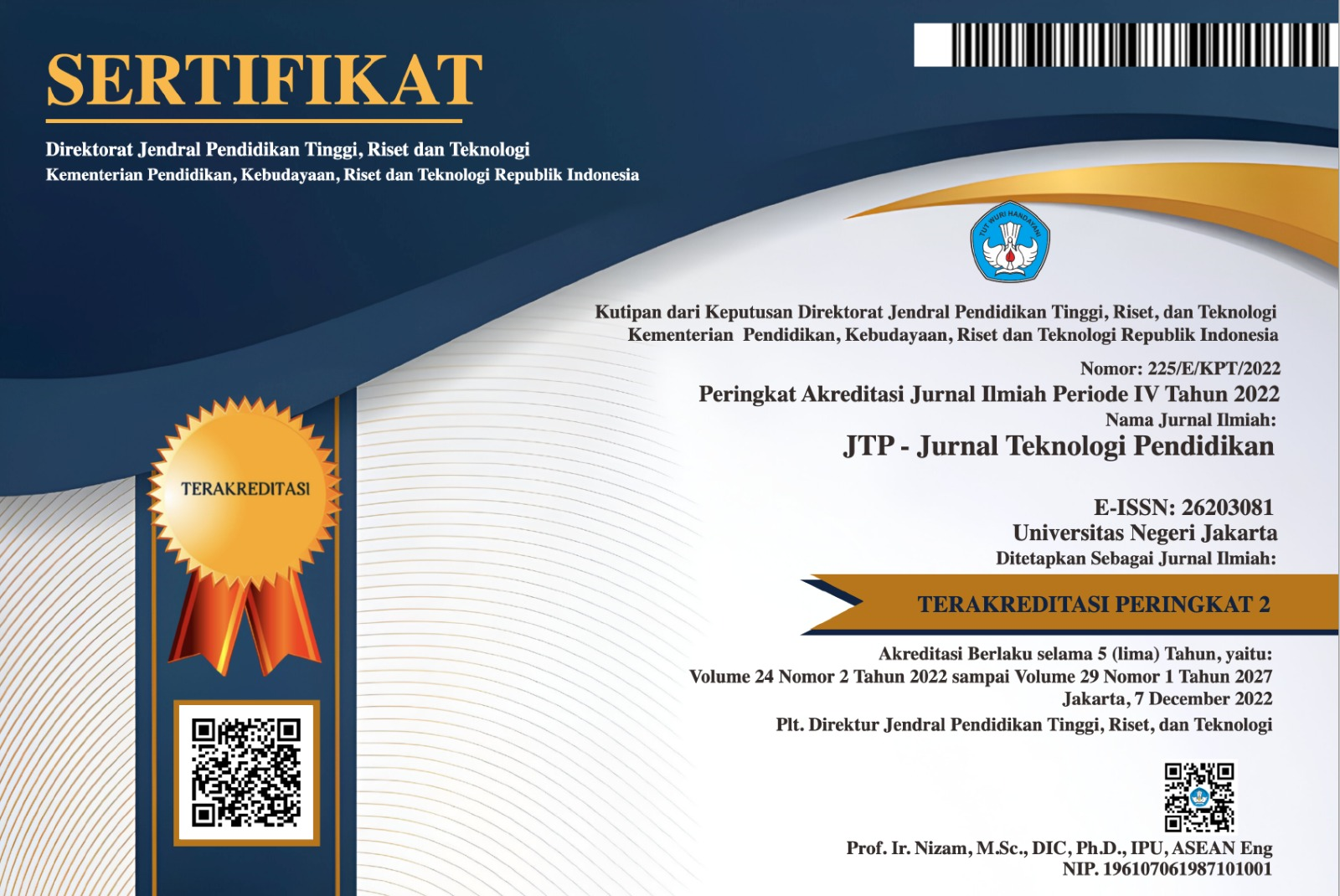Implementation of Flipped Classroom Model in Vocational High School: A Systematic Literature Review
Abstrak
This research aims to provide a comprehensive overview of flipped classroom implementation in Indonesian Vocational High School (VHS). Articles were searched using Google Scholar and selected using the PRISMA (Preferred Reporting Items for Systematic reviews dan Meta-Analyses) method. Only articles indexed by Sinta (a scientific database designed by the Ministry of Researcher, Technology and Higher Education of The Republic of Indonesia) or Scopus were used. Twenty-nine articles were included, published from 2017 to 2021. The results revealed that flipped classroom in Indonesian VHS impacts students' interests and motivation. Moreover, it impacts students' affective, cognitive, and psychomotor competencies and personal skills in the form of self-efficacy, critical thinking, problem-solving, communication, and resilience. Various learning media and tools can be integrated into out-of-class and in-class activities, embodied in learning design. As the topic of future research, the authors recommended investigating the impact of the flipped classroom on other research areas, integrating flipped classroom with other learning models and evaluating the effectiveness, also developing learning media to improve the learning outcomes.
Referensi
Bariyah, S. H. (2019). Implementasi E-learning Dengan Model Flipped Classroom Dalam Aktivitas Belajar Siswa Pada Mata Pelajaran Sistem Komputer. Jurnal Petik, 5(2), 1–8. https://doi.org/10.31980/jpetik.v5i2.575
Basyah, A. (2018). Flipped Classroom Material Untuk Meningkatkan Minat Technopreneur Siswa SMK. Jurnal TEKNODIK, 22(1), 1–10.
Bustanil, M., Asrowi, & Ardianto, D. T. (2019). Pengembangan Media Pembelajaran Interaktif Berbasis Video Tutorial Di Sekolah Menengah Kejuruan. JTP - Jurnal Teknologi Pendidikan, 21(2), 119–134. https://doi.org/10.21009/jtp.v21i2.11568
Darmawan, W., Kuswandi, D., & Praherdhiono, H. (2020). Pengaruh Blended Learing Berbasis Flipped Classroom pada Mata Pelajaran Prakarya Terhadap Hasil Belajar Siswa Kelas X SMK. Edcomtech, 5(1), 170–179.
Fahmi, R., Friatin, L. Y., & Iriianti, L. (2020). The Use Of Flipped Classroom Model In Reading Comprehension. JALL (Journal of Applied Linguistic and Literacy, 4(1).
Faridah, N., Ridlo, S., & Saptono, S. (2021). The Influence of Flipped Classroom Learning Model Application on Problem Solving Ability and Learning Motivation. Journal of Innovative Science, 10(3), 339–347. https://journal.unnes.ac.id/sju/index.php/jise/article/view/45580
Hamid, A., & Effendi, H. (2019). Flipped Classroom sebagai Alternatif Pembelajaran pada Mata Pelajaran Dasar Listrik dan Elektronika. JTEV (Jurnal Teknik Elektro Dan Vokasional), V(1), 81–86.
Handayani, D. P., Sutarno, H., & Wihardi, Y. (2018). Design e-learning with flipped learning model to improve layout understanding the concepts basic of the loop control structure. Journal of Physics: Conference Series. https://doi.org/https://doi.org/10.1088/1742-6596/1013/1/012100
Krishna, I. P. D. M., Agustini, K., & Tegeh, I. M. (2018). Pengembangan konten Dynamic E-Learning berstrategi Flipped Classroom pada mata pelajaran Simulasi Digital Kelas X di SMKN 2 Singaraja. Jurnal Teknologi Pembelajaran Indonesia, 8(3). https://doi.org/10.23887/jtpi.v8i3.2607
Kurbanoğlu, S., & Akkoyunlu, B. (2017). Information Literacy and Flipped Learning. In Pathways into Information Literacy and Communities of Practice: Teaching Approaches and Case Studies. https://doi.org/10.1016/B978-0-08-100673-3.00006-X
Laksana, E. A. (2020). Learning Model Development Framework With Flipped Classroom Method and Smart Learning Diagnosis System for Vocational High School. 17(10), 3271–3277.
Lalian, O. N., Siregar, E., & Winarsih, M. (2020). Blended Learning for Chassis Maintenance and Light Vehicle Power Transfer Subject. Jurnal Pendidikan Dan Pengajaran, 53(2), 138. https://doi.org/10.23887/jpp.v53i2.25122
Mas’ud, H., & Surjono, H. D. (2018). The Implementation of Flipped Classroom Learning Model Using Moodle To Increase Students’ Higher Order Thinking Skills. Journal of Educational Science and Technology (EST), 4(3), 187. https://doi.org/10.26858/est.v1i1.6521
Meilantari, N. L. G. (2021). Penerapan Flipped Classroom Pada Pembelajaran Daring Bahasa Jepang Di Kelas XII Smk Saraswati 3 Denpasar. JPBJ (Jurnal Pendidikan Bahasa Jepang), 7(1), 80–89.
Mudiarta, I. M. D. R., Divayana, D. G. H., & Setemen, K. (2021). The simulation of alkin evaluation model based on SAW to evaluate flip learning in IT vocational schools. Journal of Physics: Conference Series, 1810(1). https://doi.org/10.1088/1742-6596/1810/1/012063
Murni, V., Dewi, R., Jehadus, E., & Sugiarti, L. (2021). Hubungan Antara Minat Belajar Dengan Resiliensi Matematis Pada Masa Pandemi COVID-19. Jurnal Cendekia : Jurnal Pendidikan Matematika, 5(2), 1147–1158. https://doi.org/10.31004/cendekia.v5i2.546
Nugroho, R. A., Basori, B., & Maryono, D. (2020). Combining Flipped Classroom and Mind Mapping in Indonesian Vocational Schools: Their Influence to Students’ Critical Thinking Ability. IJIE (Indonesian Journal of Informatics Education), 4(1), 24–30. https://doi.org/10.20961/ijie.v4i1.44727
Oktarina, R., -, A., -, M. G., -, F., Muskhir, M., & Effendi, H. (2021). The Effect of The Use of Multimedia Flip Book With the Flipped Classroom Approach in Vocational School. Journal of Education Technology, 5(1), 159–166. https://doi.org/10.23887/jet.v5i1.31435
Pudjianto, U., Saurina, N., Hadi, F., & Adisusilo, A. K. (2021). Meningkatkan Motivasi Belajar Menggunakan Metode Pembelajaran Flipped Classroom. Didkatis: Jurnal Pendidikan Dan Ilmu Pengetahuan, 21(1), 86–93. https://www.ejournal.stkipbudidaya.ac.id/index.php/jc/article/view/377
Rusnawati, M. D. (2020). Implementasi Flipped Classroom Terhadap Hasil Dan Motivasi. Jurnal Ilmiah Pendiidikan Dan Pembelajaran, 4(April), 139–150.
Ruswana, A. M. (2019). Applıcatıon Of Flıpped Classroom Learnıng Models Wıth Peer Instructıon Flıpped Type To Improve The Mathematıcal Problems Solvıng Abılıty Of Pre- Prosperous Students. Jurnal Inovasi Pendidikan Matematika, 7(2), 168–183.
Sakti, R. H., & Sukardi, S. (2021). Empirical Effect: Flipped Classroom-Based E-Learning to Face Learning on Covid-19 Pandemic. Jurnal Pendidikan Dan Pengajaran, 54(1), 1–8. https://doi.org/10.23887/jpp.v54i1.31645
Sakti, R. H., Sukardi, S., Giatman, M., Nazar, E., Wakhinuddin, W., & Waskito, W. (2020). Flipped Classroom-Computer Based Instruction untuk Pembelajaran Revolusi Industri 4.0: Rancang Bangun dan Analisis Kebutuhan. Edumatic : Jurnal Pendidikan Informatika, 4(1), 63–72. https://doi.org/10.29408/edumatic.v4i1.2074
Seemiller, C., & Grace, M. (2017). Generation Z: Educating and Engaging the Next Generation of Students. About Campus: Enriching the Student Learning Experience, 22(3), 21–26. https://doi.org/10.1002/abc.21293
Sucipto, T. L. A., Efendi, A., Hanif, H. N., & Budiyanto, C. (2017). The Influence of Learning Management Technology to Student’s Learning Outcome. IJPTE : International Journal of Pedagogy and Teacher Education, 1(1), 11–18. https://doi.org/10.20961/ijpte.v1i1.4606
Sukayanti, L. R., Sudarma, I. K., & Jampel, I. N. (2018). Pengembangan Blended Learning Tipe Flipped Classroom Pada Mata Pelajaran Seni Budaya Kelas Xi. Jurnal EDUTECH Universitas Pedidikan Ganesha, 6(1), 134–146. https://ejournal.undiksha.ac.id/index.php/JEU/article/view/20279
Sumardi, Anisa, K. D., & Aniq, L. N. (2020). ORAL PEER FEEDBACK IN A FLIPPED SPEAKING JOB INTERVIEW CLASS: PRACTICE AND LEARNERS’ ATTITUDES. JEELS (Journal of English Education and Linguistics Studies), 2(7), 245–268.
Supriadi, N., Man, Y. L., Pirma, F. O., Lestari, N. L., Sugiharta, I., & Netriwati. (2021). Mathematical reasoning ability in linear equations with two variables: The impact of flipped classroom. IOP Conference Series: Earth and Environmental Science, 1796(1). https://doi.org/10.1088/1742-6596/1796/1/012022
Usmadi, U., & Ergusni, E. (2019). Penerapan Strategi Flipped Classroom dengan Pendekatan Scientific dalam Pembelajaran Matematika pada Kelas XI SMKN 2 Padang Panjang. Jurnal Eksakta Pendidikan (Jep), 3(2), 192. https://doi.org/10.24036/jep/vol3-iss2/333
Widyastuti, D., & Sujadi, A. A. (2018). Upaya Meningkatkan Kreativitas Dan Hasil Belajar Matematika Dengan Model Pembelajaran Flipped Classroom Di Kelas XII SMK N 1 Gedangsari. UNION: Jurnal Ilmiah Pendidikan Matematika, 6(1), 83–90. https://doi.org/10.30738/.v6i2.2003
Wirasatriya, P. A., Wahyuni, D. S., & Sindu, I. G. P. (2020). Efektivitas Media E-Learning Dengan Model Flipped Classroom Pada Mata Pelajaran Komputer Dan Jaringan Dasar. Karmapati, 9(2), 160–171. https://ejournal.undiksha.ac.id/index.php/KP/article/view/26649
Zamnah, L. N. (2019). Implementation of peer instruction flipped classroom to improve self-efficacy of underprivileged students. Jurnal Pendidikan Dan Pengajaran, 52(2), 69–74.
##submission.copyrightStatement##
##submission.license.cc.by-sa4.footer##Jurnal Teknologi Pendidikan is an Open Access Journal. The authors who publish the manuscript in Jurnal Teknologi Pendidikan agree to the following terms.
Attribution-ShareAlike 4.0 International (CC BY-SA 4.0)
-
Attribution — You must give appropriate credit, provide a link to the license, and indicate if changes were made. You may do so in any reasonable manner, but not in any way that suggests the licensor endorses you or your use.
-
ShareAlike — If you remix, transform, or build upon the material, you must distribute your contributions under the same license as the original.
- No additional restrictions — You may not apply legal terms or technological measures that legally restrict others from doing anything the license permits.
Notices:
- You do not have to comply with the license for elements of the material in the public domain or where your use is permitted by an applicable exception or limitation.
- No warranties are given. The license may not give you all of the permissions necessary for your intended use. For example, other rights such as publicity, privacy, or moral rights may limit how you use the material.








